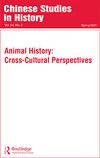中国历史上的佛教文学——编者简介
IF 0.2
4区 历史学
0 ASIAN STUDIES
引用次数: 0
摘要
佛教始于公元前5世纪的印度北部,并于公元1世纪通过丝绸之路经中亚逐渐传入中国,对中国文化的发展产生了广泛而重大的影响。以至于在20世纪上半叶,可以说是现代中国最杰出的学者胡适(1891-1962)创造了“印度化”这个词来描述佛教在过去两千年里对中国文化的深刻影响。“事实上,世界上没有任何地方,”胡宣称,“除了欧洲的基督教化之外,人们可以找到另一个在范围和时间长度上与之相当的历史资料来源。”此外,根据他的说法,佛教对中国文化的影响程度超出了宗教领域。事实上,“佛教在中国不再是一个重要而强大的宗教之后,它继续在印度化中国,”胡强调。换句话说,佛教最终演变成一种复杂的历史力量,影响了中国文化的发展,尽管最初作为一种新颖的宗教信仰吸引了许多中国人。如果我们再借用胡适的智慧,中国的印度化经历了大量借用、反抗和迫害、归化和挪用四个阶段。这里没有足够的篇幅来详细讨论胡的四个分析阶段。我只想说,佛教产生了广泛的影响,因为它的教义融入了中国本土的哲学、文学和宗教传统,导致了佛教的本土化,使它从印度的根源转变为中国本土的信仰。公元二世纪中叶,来自印度和中亚的外国佛教传教士来到中国,开始将佛经翻译成中文,中国佛教文学开始发展。最初,中国人对佛教知之甚少,佛教的宗教标志和实践经常与道教或其他本土宗教实践混合在一起。公元四、五世纪以后,佛教僧侣,如Kum arajj ā va(公元385-409年),他们对佛教教义和印度语有更先进的知识,翻译出更准确、更优雅的译文,取代了以前的译文,对中国文学的内容和形式都产生了深远的影响。除了翻译之外,中国僧侣还撰写了自己的哲学问题论文,对翻译的经文,历史和圣徒传记,诗歌和通俗叙事的评论。其中一些作品被有意或错误地归因于印度作者,并被佛教学者贴上“真伪可疑的经文”或“假经文”的标签。伪经的存在和对伪经的争论促使中国僧侣踏上了前往印度的危险之旅,以寻找“真正的”经典,并带回最新的佛教教义。最著名的是唐朝僧人玄奘(公元602-664年),他在印度呆了17年,后于公元645年回到都城长安,并建立了一个大型翻译局,翻译了他从印度带回的一些梵文典籍。游记《大唐西域记》记载了玄奘沿着丝绸之路的朝圣之旅,与他的旅程有关的故事和传说启发了明代小说家吴承恩(约1500-1582年)的《西游记》,这是中国四大名著之一。本文章由计算机程序翻译,如有差异,请以英文原文为准。
Buddhist literature in Chinese history—Editors’ introduction
Beginning in northern India in the fifth century BCE and gradually making its way to China through the Silk Roads via Central Asia in the first century CE, Buddhism had a wide-ranging and significant impact on the advancement of Chinese culture. So much so that during the first half of the twentieth century, Hu Shi 胡適 (1891–1962), arguably the most illustrious scholar in modern China, coined the term “Indianization” to describe Buddhism’s profound influence in shaping the culture of China over the previous two millennia. “Indeed, nowhere in the world,” Hu proclaimed, “with the only possible exception of the Christianization of Europe, can one find another source of historical materials equal in extent and in length of time.” Moreover, according to him, the extent to which Buddhism influenced Chinese culture extended beyond the religious realm. Indeed, “It [Buddhism] continued to Indianize China long after it had ceased to be a vital and powerful religion in China,” Hu emphasized. In other words, Buddhism eventually evolved into a complex historical force that influenced the development of Chinese culture, despite initially drawing many Chinese as a novel religious belief. The Indianization of China, if we want to borrow Hu Shi’s wisdom again, went through four phases: mass borrowing, resistance and persecution, domestication, and appropriation. There is not enough room here to go into the specifics of Hu’s four phases of analysis. Suffice it to say that Buddhism had a wide-ranging impact because its teachings were infused with Chinese native philosophical, literary, and religious traditions, resulting in a localization of Buddhism that transformed it from its Indian roots into a native Chinese faith. When foreign Buddhist missionaries from India and Central Asia arrived in China in the mid-second century CE and began translating Buddhist scriptures into Chinese, the development of Chinese Buddhist literature began. Initially, the Chinese had little understanding of Buddhism, and its religious icon and practice were frequently mixed with Daoist or other indigenous religious practices. After the fourth and fifth centuries, Buddhist monks, such as Kum arajīva (fl. 385–409 CE), who had more advanced knowledge of Buddhist teachings and Indic languages, produced more accurate and elegant translations, replacing the previous ones, and had a profound impact on both the content and form of Chinese literature. In addition to translation, Chinese monks wrote their own treatises on philosophical problems, commentaries on translated scriptures, historiography and hagiography, poetry, and popular narrative. Some of these writings were intentionally or mistakenly attributed to Indian authors and labeled by Buddhist scholars as “scriptures of doubtful authenticity” (疑經 yijing) or “spurious scriptures” (偽經 weijing). The existence of and debates over apocrypha inspired Chinese monks to embark on a perilous journey to India in search of “true” scriptures and bring back updated Buddhist teachings. The most famous was Tang dynasty monk Xuanzang (602–664 CE), who spent 17 years in India before returning to the capital Chang’an in 645 CE and establishing a large translation bureau to translate some of the Sanskrit texts he brought back from India. The travelogue The Great Tang Records on the Western Regions (大唐西域記 Da Tang xiyu ji) chronicled Xuanzang’s pilgrimage along the Silk Roads, and the stories and legends associated with his journey inspired Ming Dynasty novelist Wu Cheng’en’s (c. 1500–1582) Journey to the West (西遊記 Xi you ji), one of the four most famous traditional Chinese novels.
求助全文
通过发布文献求助,成功后即可免费获取论文全文。
去求助
来源期刊

CHINESE STUDIES IN HISTORY
Multiple-
CiteScore
0.20
自引率
0.00%
发文量
5
期刊介绍:
Chinese Studies in History makes noteworthy works and important trends of historical study in the Chinese-speaking world available to English-language readers. Thematic issues present original papers or articles from academic journals and anthologies that have been selected for translation because of their excellence, interest, and contribution to scholarship on the topic. Topical coverage ranges over all periods and subfields of Chinese and East Asian history as well as more general theoretical and historiographical questions of interest to historians of many specialties. Each issue includes a substantive introduction by the editor or specialist guest editor.
 求助内容:
求助内容: 应助结果提醒方式:
应助结果提醒方式:


